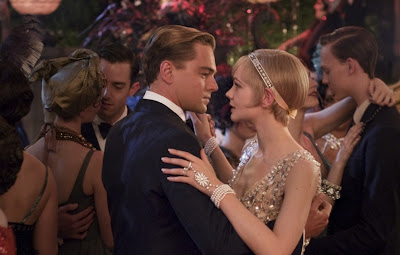 |
| Warner Bros. |
First take F. Scott Fitzgerald’s 1925 The Great Gatsby, the quintessential Great American Novel following
a young New York writer and the torrid love affair of his luxurious and
mysterious neighbor Jay Gatsby. Then add Baz Luhrmann, ostentatious Australian
director of such films as Romeo + Juliet and
Moulin Rouge!. Throw in some big budget 3D visuals, add in a
pinch of contemporary alt rock and hip-hop, bake for 143 minutes, and you get
2013’s The Great Gatsby. Starring Tobey Macguire as Nick Carraway,
Carey Mulligan as the elegant Daisy, Joel Edgerton as her polo-playing husband
Tom Buchanan, and Leonardo DiCaprio as the eponymous Gatsby, the film has all
the pomp and circumstance of the original novel but none of the passion,
resulting in a beautiful but ultimately hollow picture.
Originally planned for release last fall but delayed to the
early summer, Luhrmann’s adaptation marks the fifth attempt at adapting Fitzgerald’s
novel to screen. Exploding onto the
world stage in 1996 with his marriage of Shakespeare and 90’s pop culture Romeo + Juliet, the director is known
for his visually fantastical style, music-driven sequences, and relative lack
of subtlety. With a camera that pans and
zooms all around a digitally-created New York City and Long Island and an
eclectic soundtrack of contemporary music composed by Brooklyn’s own Jay-Z, that
trademark Luhrmann style is strongly intact, for better or for worse. If there’s anything to applaud in this film,
it’s the unrelenting visual spectacle of it all; the first forty minutes is
filled with swooping scenery shots, gorgeous imagery, and most importantly, the
bombastic insanity of Gatsby’s mansion parties.
There are waterfalls of glitter, will.i.am thudding through the air, and
too many decked-out guests to count, a cacophony of light and sound that fits
more into our era than the 1920’s. The
designs are great and the costumes are spectacular, and while it all has little
bearing upon the actual story outside of saying “Gatsby’s parties are wild”, it’s
still quite impressive. There’s an
excitable sense of earnestness to the early portions, although the
anachronistic nature does start to lose its novelty as the film goes
forward.
Shortly after formal introduction of DiCaprio’s Gatsby,
however, Luhrmann’s signature bombastic filmmaking falls to the wayside and,
outside of a few instances, more or less disappears. In his quest to remain faithful to the
original novel, which he admittedly succeeds in, the exuberance is pared down
immensely and the allure starts to wear off, with even the parties feeling more
gaudy than impressive. Although the actors never lose their sense of
theatricality, particularly during a tense apartment scene, the whole affair
starts to become rather boring, like it’s going through the motions. The film feels lost, confused, and admittedly
empty; it doesn’t really know what it wants to be anymore, Luhrmann’s film or
Fitzgerald’s story, so it attempts to be both and utterly fails. After the explosive first third, Gatsby more or less limps towards its
ending.
The characters here are, for the most part, well-casted. Carey Mulligan is appropriately angelic as
Daisy, reviving that voguish beauty of the 1920’s and stirring up great
chemistry with DiCaprio. Joel Edgerton
gives a solidly swarthy performance as Tom Buchanan, knowing who he’s acting
for and dialing in the appropriate hamminess.
Jason Clarke and Isla Fisher give good performances as George and Myrtle
respectively, but the characters feel so slight and underused in comparison to
the novel that the roles are relatively thankless. However, the most miscast role is easily
Tobey Macguire as Nick Carraway. Despite
being the narrator of the film, essentially our eyes and ears into the world of
Gatsby, Macguire’s performance is so emotionless and ineffectual that it truly
becomes hard to connect, especially after the spectacle moves on. He moves through the film like a ghost, his
line readings flatter than paper, and once Gatsby disappears and we’re left
with Carraway for the final ten minutes, it’s a struggle to find a reason to
care.
Perhaps unsurprisingly, the best acting work in the film
goes to Leonardo DiCaprio as the elusive yet restless Jay Gatsby. Films such as J. Edgar and Django Unchained
have been exemplifying the actor’s age, and yet there are moments in The Great Gatsby where he looks the
youngest he has in years; while Gatsby is tossing J. Crew shirts at a laughing
Carey Mulligan, his face and hers shining in the sunlight, one could swear that
DiCaprio has travelled back in time a decade, his smile the same as it was in Romeo + Juliet. He does well in the dramatic scenes in the
latter parts of the film, brooding and screaming and contemplating, but it’s
during those scenes of swagger and bravado, of Gatsby the Legend as opposed to
Gatsby the Man, that DiCaprio, and by extension the film, truly shines.
When the lights came up at our screening, a friend of mine
made an observation about the film that more or less hits the nail on the head,
saying, “It’s like having this great beautiful box, and then you open it up and
there’s nothing inside.” It’s safe to
say that there’s little of note inside the film The Great Gatsby, a mixture of story and style that could have
worked together well but ended up clashing and crashing into a mess of sound
and color. What we’re treated to is
essentially two films, one where the style overpowers the story, and another
where the story overpowers the style, and neither truly works. There are scattered fragments of a great
film, real moments of awe, but they’re buried underneath hours of confusion. On the whole, The Great Gatsby is a magnificent failure, but a failure
nonetheless.
Grade: C
No comments:
Post a Comment